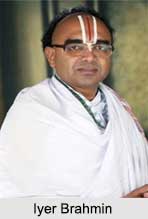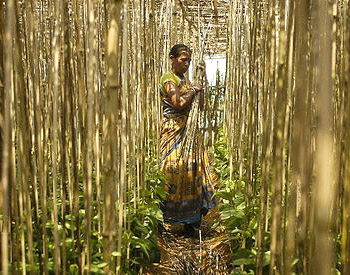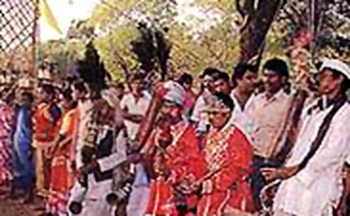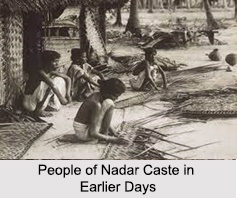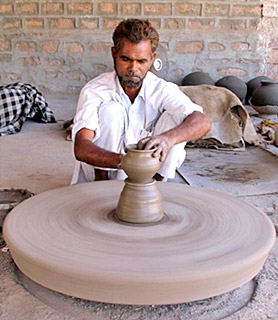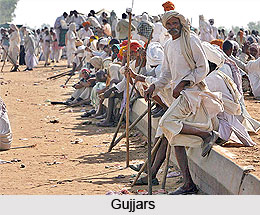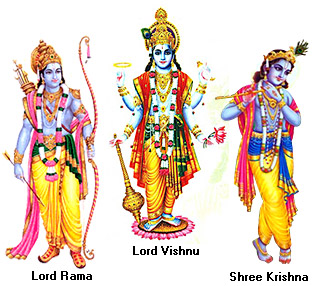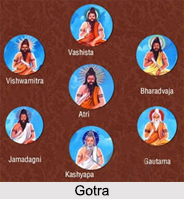About Worship of Lord Ganesha
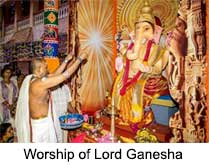 Worship of Lord Ganesha in Hinduism has been a custom among the followers to invoke Lord Ganesha at the beginning of prayers as well as in all ceremonies and cultural festivals. Lord Ganesha represents the power of the Supreme Being that takes away obstacles and guarantee victory in human accomplishments. By tradition, every religious festival begins with the worship of Lord Ganesha. He is also worshipped in Jainism and Buddhism.
Worship of Lord Ganesha in Hinduism has been a custom among the followers to invoke Lord Ganesha at the beginning of prayers as well as in all ceremonies and cultural festivals. Lord Ganesha represents the power of the Supreme Being that takes away obstacles and guarantee victory in human accomplishments. By tradition, every religious festival begins with the worship of Lord Ganesha. He is also worshipped in Jainism and Buddhism.
Lord Ganesha is one of the most popular Gods of Hinduism. Millions of Hindus revere him every day in temples and homes with utmost devotion. Ganesha is worshipped ritually by his devotees because of his status in the Hindu pantheon as the leader of the Gods. He has numerous temples in various parts of the world which are regularly visited by his devotees to offer worship and express their fears and concerns.
Reference of Worship of Lord Ganesha
In ancient Hindu scriptures, there are many references about worship of Lord Ganesha, the first of such reference is been found in the Rig Veda. There are also references in the great epics of Ramayana and Mahabharata, all of which indicate that the worship of Lord Ganesha dates back prior to 7,000 years ago or even earlier. The worship of Lord Ganesha has a long history, which dates back to at least pre-Gupta period or even earlier.
Reasons for Worship of Lord Ganesha
Every form of worship of Lord Ganesha has its own specific explanation. There are many reasons for believers for worshipping Lord Ganesha. Ganesha is an earthy god who combines in himself the powers of God and Nature. He is the "Vighnaharta" or the destroyer of all obstacles. As the remover of obstacles, and the upholder of Dharma, he also facilitates material as well as spiritual success in the mortal world by helping people achieve the four aims of human life. Worshipping Ganesha is considered very auspicious and beneficial for health and happiness. Lord Ganesha is one of the few Hindu Gods, who is said to solve all kinds of troubles and touch all aspects of human life with his holy presence.
Worship by Shiva
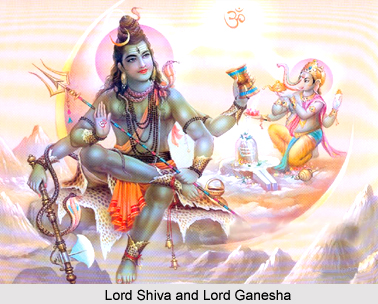 The legend related to the worship of Lord Ganesha by Lord Shiva is mentioned in the Puranic texts. In the Treta Yuga, there was a prominent sage named Gritsamada. One day the sage had a cough and a child emerged from it. The child named Tripurasura grew up rapidly and intended to conquer the three lokas or worlds. He also desired to defeat Lord Indra. Sage Gritsamada wanted to change his mind and thus asked Tripurasura to worship and praise Lord Ganesha. Hence he began to meditate on the elephant headed deity. Lord Ganesha became pleased by the devotion of Tripurasura and blessed. The deity told him to ask for a boon. Tripurasura requested for three separate forts made of gold, silver and iron respectively. Thus Ganesha presented him with three forts (Tripura); the golden fort was constructed in heaven, the silver fort located in the sky and the iron fort was on the earth. The Lord also announced that only Lord Shiva would be able to defeat the demon Tripurasura with one arrow and destroy the three forts.
The legend related to the worship of Lord Ganesha by Lord Shiva is mentioned in the Puranic texts. In the Treta Yuga, there was a prominent sage named Gritsamada. One day the sage had a cough and a child emerged from it. The child named Tripurasura grew up rapidly and intended to conquer the three lokas or worlds. He also desired to defeat Lord Indra. Sage Gritsamada wanted to change his mind and thus asked Tripurasura to worship and praise Lord Ganesha. Hence he began to meditate on the elephant headed deity. Lord Ganesha became pleased by the devotion of Tripurasura and blessed. The deity told him to ask for a boon. Tripurasura requested for three separate forts made of gold, silver and iron respectively. Thus Ganesha presented him with three forts (Tripura); the golden fort was constructed in heaven, the silver fort located in the sky and the iron fort was on the earth. The Lord also announced that only Lord Shiva would be able to defeat the demon Tripurasura with one arrow and destroy the three forts.
Tripurasura became arrogant after receiving the boon from Lord Ganesha and started to create havoc in the Universe. He defeated all the gods in the heaven and all the kings on the earth. The demon had 2 sons. He gave the kingdom of Lord Vishnu to one of his sons and the kingdom of Lord Bramha to the other son.
Then Sage Narada told all the gods and devas to worship and pray to Lord Ganesha who appeared before all the gods. The deity said that only Lord Shiva can annihilate Tripurasura and destroy the three forts. Afterwards Lord Ganesha took the disguise of a Brahmana (Brahmin) and went to visit Tripurasura. The Brahmana told the demon that he was master of sixty four arts. Tripurasura asked the Brahmana to display his arts and if he was impressed, the demon would grant him a boon.
Lord Ganesha then said that he would present him with 3 aircrafts which would take Tripurasura to anywhere in the world. Only Lord Shiva would be able to destroy them. The demon became immensely pleased with this and asked the Brahmana (Ganesha) to request for any gift in return. The Brahmana desired to have the Chintamani which was possessed by Shiva himself. When Tripurasura went to Shiva or Maheshwara to ask for the Chintamani idol, Lord Shiva refused. This resulted in a war between Tripurasura and Shiva. Shiva prayed and worshipped Lord Ganesha and went on a chariot that was built by Lord Vishwakarma, the architect of the gods. Prithvi served as the chariot while the sun and the moon became the wheels. Lord Brahma became the charioteer. Vishwakarma also made the bow and arrow of Lord Shiva. Meru became the bow and Lord Vishnu became the arrow.
After a fierce battle, Shiva destroyed the three forts and the three aircrafts with a single arrow. When Lord Shiva released the divine arrow, lighting emitted from it. Tripurasura became unconscious by the intense light of the arrow and the soul (atma) of the demon emerged of his body in the form of Jyoti. It then entered Lord Shiva.
Another version of the legend states that the Maha Ganapati form of Lord Ganesha was worshipped by Lord Shiva to slay the demon. Tripurasura was a staunch devotee of Lord Ganesha and performed deep meditation on the deity. He was granted a boon from the elephant-headed deity that no one would be able to kill him except Lord Shiva, the Destroyer of the Universe. Eventually Tripurasura became arrogant with his newly found power and started to create disturbance in heaven and on earth.
Later the demon went to Mount Kailash and attempted to abduct Goddess Parvati, the consort of Shiva. Tripurasura thought that he controlled Kailash and it would not be difficult for him to kidnap the goddess. However, Goddess Parvati became very terrified when she realised that Tripurasura was coming to capture her. She immediately went to Himavan, the Lord of Mountains, and informed him about her condition.
Lord Himavan hid Goddess Parvati inside a cave and thus Tripurasura failed to capture the goddess. But the demon managed to seize an image of Lord Ganesha and carried it with him. While the demon was on his way, he discovered that several worshippers of Ganesha were following him. Then all of a sudden the idol of the deity vanished from his hands as well as all the worshippers. Tripurasura realized that this was not a good sign and returned to his forts (Tripura).
Meanwhile, Lord Shiva became much concerned about the evil activities of the dastardly demon. The sage Narada advised Lord Shiva to worship Lord Ganesha. After receiving the blessings of Lord Maha Ganapati, Shiva attacked Tripurasura and successfully vanquished the demon and destroyed his three forts.
There is another version of the legend that states that Tripurasura referred to three asuras or demons named Viryavana, Tarakaksha and Vidyunmali. They were the sons of Tarakasura. The three demons performed long tapas on Lord Brahma. The three demons meditated standing on one leg for almost one hundred years. Later they continued their meditation for another thousand years and consumed only air. Brahma became pleased with their tapas and blessed them with three forts (Tripura) made of gold, silver and iron. Each of the forts was as big as a city and included many palaces and vimanas (aircrafts).
Later the 3 asuras started to create mayhem in heaven and earth. After one thousand years all the three forts merged together and became a single gigantic fort. Then Lord Shiva praised and adored his son Ganesha to seek help in slaughtering the three Tripurasura demons. Ganesha blessed Shiva and told him the way to defeat the asuras. Lord Shiva installed the Pasupata, a celestial weapon, in his arrow and shot at Tripura. It destroyed the fort and burned Tripura.
Worship by Parvati
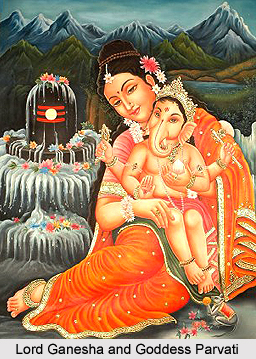 The Puranic texts mention that Lord Ganesha was adored and worshipped by Goddess Parvati. The ancient legend mentions that once the King of Lanka, Ravana, engaged in deep meditation or tapas on Lord Shiva to acquire the Atma Linga which would make him immortal. As the Lord of destruction was pleased by the devotion of Ravana, Shiva asked Ravana to request for whatever he desires. However, Ravana asked for Goddess Parvati, Shiva`s consort, due to the interference of Lord Vishnu and Sage Narada.
The Puranic texts mention that Lord Ganesha was adored and worshipped by Goddess Parvati. The ancient legend mentions that once the King of Lanka, Ravana, engaged in deep meditation or tapas on Lord Shiva to acquire the Atma Linga which would make him immortal. As the Lord of destruction was pleased by the devotion of Ravana, Shiva asked Ravana to request for whatever he desires. However, Ravana asked for Goddess Parvati, Shiva`s consort, due to the interference of Lord Vishnu and Sage Narada.
Lord Shiva had no other option and hence gave Parvati (Uma) to Ravana the demon king. Then Goddess Parvati worshipped and prayed to Lord Ganesha to save her from this situation and create obstructions and hindrances in the way of Ravana. Ganesha granted her wish and took the form of a Brahmana (Brahmin). He appeared before Ravana on the way through which he planned to carry the goddess.
The elephant-faced deity informed the king of Lanka that Lord Shiva had cheated him by not presenting Ravana with the real Parvati, but an imposter. Ganesha also told that Goddess Parvati was originally hiding in the abode of Maya Danava in Patala or Naraka (Nether World). Ravana believed the Brahmana and immediately left Parvati. He went to the abode of Maya in pursuit of Parvati. There he fell in love with Mandodari who was the daughter of Maya. Thus, Ravana married Mandodari asked for forgiveness from Lord Shiva and Goddess Parvati and prayed to them.
Worship by Brahma
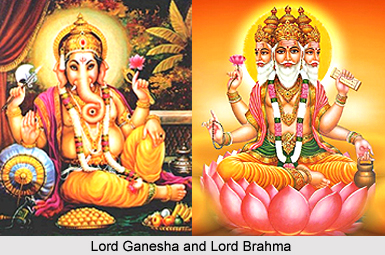 The Puranic texts mention that Lord Ganesha is worshipped by Lord Brahma. This is mentioned in one of the legends related to the birth of Lord Ganesha. According to the Shiva Purana, Goddess Parvati created Ganesha from turmeric paste which she used to wash her body. He was instructed by the goddess to guard her abode. Later Lord Shiva, the husband of Parvati, returned home but was prevented by Ganesha. Shiva became enraged and decapitated the divine child. Then Goddess Parvati demanded that Shiva restore his life immediately. Hence Lord Brahma suggested Shiva to replace the head of Ganesha with the head of a dying elephant. Shiva then attached the elephant head to the body of Ganesha and brought him back to life.
The Puranic texts mention that Lord Ganesha is worshipped by Lord Brahma. This is mentioned in one of the legends related to the birth of Lord Ganesha. According to the Shiva Purana, Goddess Parvati created Ganesha from turmeric paste which she used to wash her body. He was instructed by the goddess to guard her abode. Later Lord Shiva, the husband of Parvati, returned home but was prevented by Ganesha. Shiva became enraged and decapitated the divine child. Then Goddess Parvati demanded that Shiva restore his life immediately. Hence Lord Brahma suggested Shiva to replace the head of Ganesha with the head of a dying elephant. Shiva then attached the elephant head to the body of Ganesha and brought him back to life.
After Ganesha was reborn, Lord Brahma went to the elephant faced child and assigned him as Ganapati the leader of the Ganas, the divine army of Lord Shiva. He also presented various other gifts to the child. Lord Brahma then declared that Lord Ganesha would be worshipped first and before any other god. Brahma also appointed the child as the remover of all obstacles in heaven and earth.
Worship by Vishnu
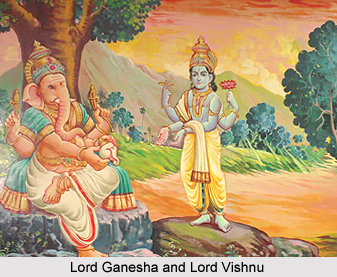 The legend related to the worship of Lord Ganesha by Lord Vishnu is mentioned in the Ganesha Purana which is exclusively devoted to Lord Ganesha. The myth states that Lord Brahma was the creator of the Universe and recited the Vedas. He emerged from the navel of Lord Vishnu and was seated over the lotus throne. While Lord Vishnu was resting over the serpent bed, 2 fierce asuras or demons named Madhu and Kaitabha were formed from the wax emerging out of the ears of Vishnu. These demons began to create obstructions for the gods, sages and humans. As an effect of this, Lord Vishnu woke up from his divine sleep and saw the commotion in heaven and earth.
The legend related to the worship of Lord Ganesha by Lord Vishnu is mentioned in the Ganesha Purana which is exclusively devoted to Lord Ganesha. The myth states that Lord Brahma was the creator of the Universe and recited the Vedas. He emerged from the navel of Lord Vishnu and was seated over the lotus throne. While Lord Vishnu was resting over the serpent bed, 2 fierce asuras or demons named Madhu and Kaitabha were formed from the wax emerging out of the ears of Vishnu. These demons began to create obstructions for the gods, sages and humans. As an effect of this, Lord Vishnu woke up from his divine sleep and saw the commotion in heaven and earth.
The Lord decided to eliminate the demons and remove the obstructions created by them. Thus he created a thundering sound with His divine Shankha or conch shell. The reverberating sound of the conch frightened the Universe. Then demons Madhu and Kaitabha attacked Vishnu at the same time. The deity fought against the asuras for a period of five thousand years but he failed to defeat them.
Then Lord Vishnu took the form of Gandharva, a beautiful musician deity. He began to play a veena after reaching a forest. All the animals in the forest started to dance at the tune of the divine music. Meanwhile, Lord Shiva also heard the music of Vishnu. Then Pushpadanta and Nikumbha also took the form of Gandharvas and reached the forest by following the music. They prayed to Lord Vishnu to go to Lord Shiva in Mount Kailash.
Vishnu then went to Kailash and bowed down at the feet of Lord Shiva. Shiva then welcomed and embraced Vishnu and offered him a seat. Lord Vishnu became gratified to consult with Shiva. Then Vishnu picked up the veena and began to play it. Lord Shiva, His consort Goddess Parvati, their sons Lord Ganesha and Lord Kartikeya (Skanda) and all other gods became overwhelmed with the divine music.
Pleased with Vishnu`s music, Lord Shiva granted him a boon. Vishnu requested the deity to help Him in eliminating the demons Madhu and Kaitabha as He himself failed to kill the asuras. Lord Shiva suggested Vishnu to worship Lord Ganesha before attempting to annihilate Madhu and Kaitabha. Lord Vishnu followed his advice and worshipped and prayed to Ganesha. Then Vishnu went to slay the demons and achieved success in his task. This the legend related to the worship of Ganesha by Lord Vishnu.
Worship by Tridev
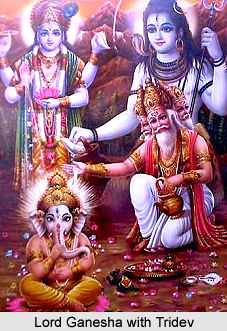 Lord Ganesha is worshipped and adored by the Tridev (Trimurti) or the Great Trinity of Lord Brahma, Lord Vishnu and Lord Shiva. Ganesha blessed them as the creator, preserver and destroyer of everything in the universe.
Lord Ganesha is worshipped and adored by the Tridev (Trimurti) or the Great Trinity of Lord Brahma, Lord Vishnu and Lord Shiva. Ganesha blessed them as the creator, preserver and destroyer of everything in the universe.
Legend of Worship of Lord Ganesha by Tridev
The Ganesha Purana cites that during the period of dissolution, the water and wind were demolished and the earth evaporated. Then Lord Brahma, Lord Vishnu and Lord Shiva began to consult and went to Naraka or netherworld to perform tapas; but it was unsuccessful.
The Tridev became exhausted and began to wander the earth which remained dark all over. The Gods spotted a lake in the darkness where an astonishing lustre appeared. They became fatigued and were unable to move. Then Brahma, Vishnu and Shiva stopped over at a particular location as they became extremely tired. There the Gods discovered huge lustre of light where Lord Ganesha was enshrined. The Tridev immediately bowed to the elephant headed Lord in reverence and began to worship and praise Him.
Ganesha became pleased by the prayers of the three Gods and told them to ask for a desirable boon. The Tridev said that they were unable to understand the reason for such occurrence. Hence, they requested Ganesha to bless them with the appropriate boon. The elephant Lord entrusted Lord Brahma, Lord Vishnu and Lord Shiva with three separate duties. Lord Brahma was instructed to engage in the task of the creation, Lord Vishnu was appointed as the preserver or maintainer of the people and Lord Shiva was assigned as the destroyer and transformer.
Worship by Gods
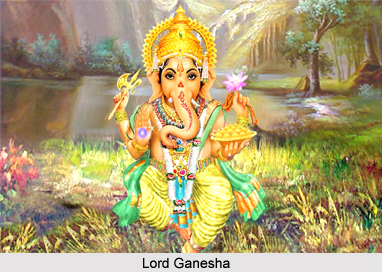 Lord Ganesha is praised and worshipped by all the gods and devas. The Puranic texts mention that the elephant headed deity should be adored first before the adoration any other deity. Ganesha was immensely worshipped by the gods in the form of Mayureshwara. In this incarnation, He was depicted with six arms and white complexion. The Lord eliminated the demon Sindhu or Sindura who terrified all the gods, sages and humans. This legend is mentioned in the Ganesha Purana, one of the Upapuranas dedicated to the Lord. After Ganesha killed the demon and rescued the gods and sages, all the deities in heaven worshipped the Mayureshwara form of Lord Ganesha showered flowers from the sky.
Lord Ganesha is praised and worshipped by all the gods and devas. The Puranic texts mention that the elephant headed deity should be adored first before the adoration any other deity. Ganesha was immensely worshipped by the gods in the form of Mayureshwara. In this incarnation, He was depicted with six arms and white complexion. The Lord eliminated the demon Sindhu or Sindura who terrified all the gods, sages and humans. This legend is mentioned in the Ganesha Purana, one of the Upapuranas dedicated to the Lord. After Ganesha killed the demon and rescued the gods and sages, all the deities in heaven worshipped the Mayureshwara form of Lord Ganesha showered flowers from the sky.
Once the gods began to perform a yajna at the northern bank of Gautami River but they encountered various obstacles. The gods failed to complete the yajna. They became worried and enquired Lord Vishnu and Lord Brahma about the reason. Brahma eventually discovered the reason and informed all the gods that Lord Ganesha himself was creating all the obstacles. Thus as result of this the yajna could not be completed. Then Lord Brahma suggested all the Brahmanas (Brahmins) to bathe in the Gautami River and then worship Lord Ganesha. Then the elephant-headed deity came before the Brahmanas and granted them their desired boon.
Worship by Radha
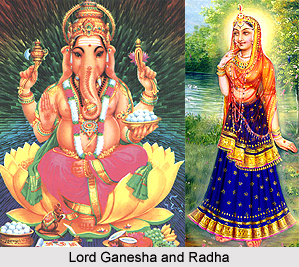 The legend of worship of Lord Ganesha by Radha is mentioned in the Mahapuranas and Upapuranas. It states that once on a full moon day of Vaisakha, Lord Shiva, Goddess Parvati, Lord Kartikeya (Skanda) and Lord Brahma went to Siddhasrama. All of the other gods and devas of heaven, along with the sages and kings of earth reached there to worship Lord Ganesha. Lord Krishna also reached the location along with all the people of Dwarka. Radha and the citizens of Gokula also went with Krishna.
The legend of worship of Lord Ganesha by Radha is mentioned in the Mahapuranas and Upapuranas. It states that once on a full moon day of Vaisakha, Lord Shiva, Goddess Parvati, Lord Kartikeya (Skanda) and Lord Brahma went to Siddhasrama. All of the other gods and devas of heaven, along with the sages and kings of earth reached there to worship Lord Ganesha. Lord Krishna also reached the location along with all the people of Dwarka. Radha and the citizens of Gokula also went with Krishna.
After reaching the place, Radha took a bath and adorned herself in new clothes. Then she went to the beautiful mandapa which was established for Ganesha worship. Radha offered white flowers to the Lord and adored Him with utmost devotion. She also offered Durva grass or Bermuda grass, holy water, lamp, incense sticks, fragrant sandalwood paste, five clothes and many other presents to Ganesha.
Radha also presented a sacred cow as charity. Afterwards she chanted the Ganesha mantra for one thousand times and also performed all other rituals related with Ganesha worship. The elephant-faced Lord was pleased with her devotion and thus appeared before her. He instructed her to distribute the offerings to the Brahmanas (Brahmins). As in this way Ganesha would be able to accept the presents. Thus Radha gave away all the presents to the Brahmanas. Ganesha became happy with the generosity of Radha and blessed her.
Worship by Asuras
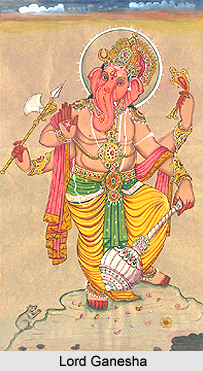 The Indian Puranas mention that Lord Ganesha is praised and worshipped by the demons or asuras. The religious scriptures mention that once there was a sage named Gritsamada. He was the son of Shunahotra and belonged to the Bhrigu family. The sage was always engaged in performing tapas on Lord Ganesha. However, one day a child (Tripurasura) emerged from his sneeze which immensely surprised the ascetic. The child then requested sage Gritsamada to raise and take care of him. The child also announced that after he grows up he will conquer the three Lokas or worlds.
The Indian Puranas mention that Lord Ganesha is praised and worshipped by the demons or asuras. The religious scriptures mention that once there was a sage named Gritsamada. He was the son of Shunahotra and belonged to the Bhrigu family. The sage was always engaged in performing tapas on Lord Ganesha. However, one day a child (Tripurasura) emerged from his sneeze which immensely surprised the ascetic. The child then requested sage Gritsamada to raise and take care of him. The child also announced that after he grows up he will conquer the three Lokas or worlds.
Gritsamada then requested the child to go to the forest and meditate on Lord Ganesha. Hence the sage told the Ganesha Mantra to the child and sent him to the forest. Tripurasura then went to a remote part of the forest and began to worship Lord Ganesha. He performed tapas for a long period and meditated without consuming food. Lord Ganesha became pleased with his devotion for the Lord and appeared before him. The elephant headed deity advised the child to ask for a boon. Tripurasura told the Lord that he was greatly influenced by Ganesha`s lustre. The child requested the deity to bless him with a boon to be the ruler of the three worlds. Lord Ganesha was pleased with his tapas and granted him the desired boon.
There is another myth that is related with the adoration of Lord Ganesha by the demon Banasura, also known as Bana. The asura was the son of Bali and had a thousand arms. The Brahmavaivarta Purana, one of the eighteen Mahapuranas, mentions that during the battle between Banasura and Lord Krishna, Lord Shiva advised the demon Banasura to worship his son Lord Ganesha before commencing battle against Krishna. Thus the asura praised and adored the elephant-faced lord and then went to the battlefield. Ganesha was pleased with his adoration and blessed him.
The right side and the left side of Banasura were protected by Lord Kartikeya (Skanda) and the he was shielded from his back by Nandi, the divine bull of Shiva and Bhairava Rudra.










